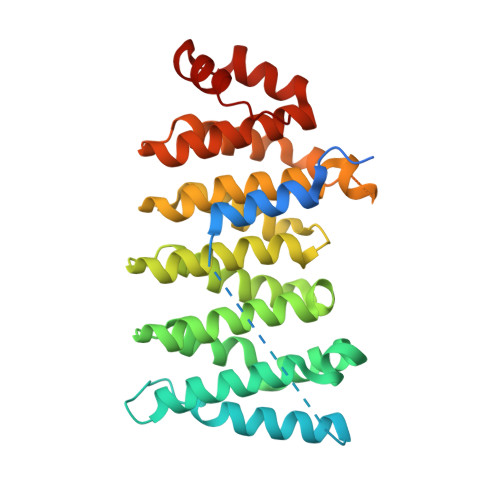An isolated CLASP TOG domain suppresses microtubule catastrophe and promotes rescue.
Majumdar, S., Kim, T., Chen, Z., Munyoki, S., Tso, S.C., Brautigam, C.A., Rice, L.M.(2018) Mol Biol Cell 29: 1359-1375
- PubMed: 29851564
- DOI: https://doi.org/10.1091/mbc.E17-12-0748
- Primary Citation of Related Structures:
6COK - PubMed Abstract:
Microtubules are heavily regulated dynamic polymers of αβ-tubulin that are required for proper chromosome segregation and organization of the cytoplasm. Polymerases in the XMAP215 family use arrayed TOG domains to promote faster microtubule elongation. Regulatory factors in the cytoplasmic linker associated protein (CLASP) family that reduce catastrophe and/or increase rescue also contain arrayed TOGs, but how CLASP TOGs contribute to activity is poorly understood. Here, using Saccharomyces cerevisiae Stu1 as a model CLASP, we report structural, biochemical, and reconstitution studies that clarify functional properties of CLASP TOGs. The two TOGs in Stu1 have very different tubulin-binding properties: TOG2 binds to both unpolymerized and polymerized tubulin, and TOG1 binds very weakly to either. The structure of Stu1-TOG2 reveals a CLASP-specific residue that likely confers distinctive tubulin-binding properties. The isolated TOG2 domain strongly suppresses microtubule catastrophe and increases microtubule rescue in vitro, contradicting the expectation that regulatory activity requires an array of TOGs. Single point mutations on the tubulin-binding surface of TOG2 ablate its anti-catastrophe and rescue activity in vitro, and Stu1 function in cells. Revealing that an isolated CLASP TOG can regulate polymerization dynamics without being part of an array provides insight into the mechanism of CLASPs and diversifies the understanding of TOG function.
- Department of Biophysics, UT Southwestern Medical Center, Dallas, TX 75390.
Organizational Affiliation:
















